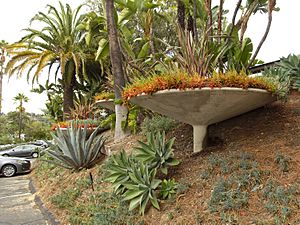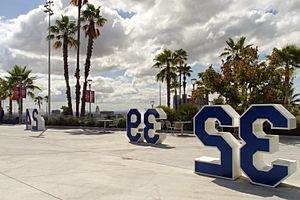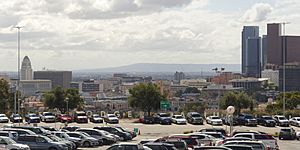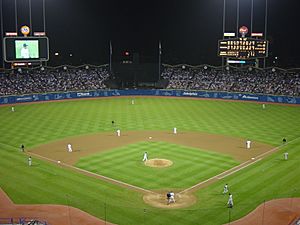Dodger Stadium facts for kids
|
Chavez Ravine
Blue Heaven on Earth |
|
 |
|
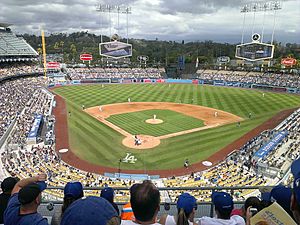
Dodger Stadium in 2015
|
|
| Address | 1000 Vin Scully Avenue |
|---|---|
| Location | Los Angeles, California, United States |
| Coordinates | 34°4′25″N 118°14′24″W / 34.07361°N 118.24000°W |
| Public transit | |
| Owner | Guggenheim Baseball Management |
| Operator | Los Angeles Dodgers |
| Type | Stadium |
| Capacity | 56,000 |
| Record attendance | 57,098 (Dodgers’ home opener, April 13, 2009) |
| Field size | Left field – 330 ft (101 m) Medium left-center – 360 ft (110 m) True left-center – 375 ft (114 m) Center field – 395 ft (120 m) True center field – 400 ft (122 m) True right-center – 375 ft (114 m) Medium right-center – 360 ft (110 m) Right field – 330 ft (101 m) Backstop – 55 ft (17 m)  |
| Surface | Santa Ana Bermuda grass |
| Construction | |
| Broke ground | September 17, 1959 |
| Opened | April 10, 1962 |
| Construction cost | US$23 million (US$223 million in 2022 ) |
| Architect | Praeger-Kavanagh-Waterbury |
| Structural engineer | William Simpson & Associates Inc. |
| Services engineer | SA Bogen Engineers |
| General contractor | Vinnell Corporation |
| Tenants | |
| Los Angeles Dodgers (MLB) (1962–present) Los Angeles Angels (MLB) (1962–1965) |
|
Dodger Stadium is a famous baseball park in Los Angeles, California. It is the exciting home of the Los Angeles Dodgers, a team in Major League Baseball (MLB). The stadium opened in 1962 and was built in less than three years. It cost about $23 million to build.
Dodger Stadium is the oldest baseball park in MLB west of the Mississippi River. It is also the third-oldest overall, after Fenway Park (1912) and Wrigley Field (1914). It is the largest baseball stadium in the world by how many seats it has. Many people call it a "pitcher's ballpark" because pitchers often do very well there. Thirteen no-hitters have happened here, including two perfect games.
The stadium has hosted the Major League Baseball All-Star Game twice, in 1980 and 2022. It has also been the site of the World Series eleven times. Dodger Stadium hosted parts of the World Baseball Classic in 2009 and 2017. It even held exhibition baseball during the 1984 Summer Olympics. Other sports like soccer and hockey games have also taken place here. The Los Angeles Angels also played their home games at Dodger Stadium from 1962 to 1965.
People sometimes call the stadium Chavez Ravine Stadium because of the area it's in. Another nickname is "Blue Heaven on Earth," which was created by former Dodgers manager Tommy Lasorda.
Contents
Building Dodger Stadium
How the Stadium Was Built
In the 1950s, Walter O'Malley, who was the president of the Brooklyn Dodgers, wanted to build a new stadium in Brooklyn. However, he couldn't agree with city officials on where to build it. So, he made a deal with the city of Los Angeles instead.
The land for Dodger Stadium was once owned by local families. The city of Los Angeles bought this land to build a large public housing project. But plans changed, and the housing project was never built. In 1958, Los Angeles voters approved a plan for the Dodgers to buy the land.
Some residents were asked to move from their homes in Chavez Ravine. This was a difficult time for many families. While Dodger Stadium was being built, the Dodgers played at the Los Angeles Memorial Coliseum. This temporary home could hold over 90,000 people.
Dodger Stadium was special because it was built entirely with private money. This means no government funds were used for its construction. Building started on September 17, 1959. Workers moved a lot of earth to create a flat area for the stadium and its large parking lot. They even buried an old school building instead of tearing it down!
Stadium Upgrades Over Time
After the 2005 baseball season, Dodger Stadium got some big updates. Almost all the seats were replaced. The new seats were in the original 1962 colors: yellow, light orange, turquoise, and sky blue. These colors gave the stadium a fresh look.
The stadium also received new LED video screens between 2003 and 2005. The main screen is 27 feet high and 47 feet wide. In 2008, the Dodgers announced plans for a huge project. This project would add a Dodger museum, shops, and restaurants around the stadium. It would also create a "Green Necklace" walkway for fans.
However, some of these big plans were put on hold. This was due to the 2009 World Baseball Classic and other financial reasons.
Modern Renovations and New Features
After the Dodgers were sold in 2012, new owners continued to improve the stadium. They installed new High Definition video boards and a better sound system. The restrooms, food stands, and batting cages were also updated.
More renovations happened between the 2013 and 2014 seasons. These included wider walkways and new restaurants. They also added special areas where fans could watch the bullpens.
In 2019, a $100 million renovation was announced. This project added a two-acre center field plaza with a children's playground. The Jackie Robinson statue was moved there. A new statue of Sandy Koufax was also planned to be unveiled next to it. These renovations also added new elevators and escalators. They made it easier for fans to move between different levels of the stadium.
Stadium Design and Special Features
Unique Design Elements
Dodger Stadium was one of the last baseball-only stadiums built before many stadiums started hosting multiple sports. It is located near major freeways in downtown Los Angeles. A huge parking lot surrounds the stadium. It is now the third-oldest park still in use in MLB. It is the oldest on the West Coast.
The stadium has some cool design features. One unique idea was a covered section of seats right behind home plate. The original area was changed in 1999, but other stadiums have copied this idea.
Two very recognizable parts of Dodger Stadium are the wavy roofs on top of each outfield section. Also, a tall elevator shaft with the Dodger logo rises behind home plate.
A special terraced parking lot was built. This allows fans to park at roughly the same level as their seats. This means less walking up and down ramps inside the stadium. The stadium was also built to be strong against earthquakes. This is very important in California.
The stadium originally had two big electronic scoreboards. The right-field board showed game information. The left-field board showed scores from other games. Over the years, these have been updated with modern video screens. In 2001, strobe lights were added. They flash when the Dodgers come out, after a home run, and after a win.
Honoring Legends: Retired Numbers and Statues
Many famous Dodgers players have their numbers retired. These numbers are displayed inside the stadium. Some of these legends include Don Drysdale (53), Sandy Koufax (32), Don Sutton (20), Pee Wee Reese (1), and Jackie Robinson (42). Other important people like broadcasters Vin Scully and Jaime Jarrin are also honored.
On April 15, 2017, a bronze statue of Jackie Robinson was unveiled. It shows him sliding into home plate. In 2022, a bronze statue of Sandy Koufax was also unveiled. It shows him in his pitching motion. Both statues are in the centerfield plaza.
Stadium Location and Weather
Dodger Stadium is built on top of the historic Chavez Ravine area. It offers amazing views of downtown Los Angeles to the south. You can also see the green hills of Elysian Park and the San Gabriel Mountains.
Because Southern California has dry summers, rainouts at Dodger Stadium are very rare. The stadium once went for 856 straight home games without a rainout. This was a major league record. As of 2019, it had gone 1,471 consecutive games without a rainout.
Seating and Capacity
Dodger Stadium has a seating capacity of 56,000. This number has stayed the same due to a special permit. When new seats are added in popular areas, some seats are removed elsewhere to keep the total the same. In 2009, a record 57,099 fans attended a game by selling standing room only tickets.
In 2008, the right-field pavilion became the "All You Can Eat Pavilion." Fans in this section can enjoy unlimited hot dogs and peanuts. They also get free soft drinks.
Field Dimensions and "Pitchers' Park" Reputation
Dodger Stadium has long been known as a "pitchers' park." This means it's a place where pitchers often do very well. This is partly because of the deep outfield dimensions. Famous pitchers like Sandy Koufax and Fernando Valenzuela became superstars here.
Night games at Dodger Stadium are especially good for pitchers. This is due to the "marine layer effect." As the sun sets, the air cools and becomes denser. This can make deep fly balls travel shorter distances. So, balls that might be home runs during the day often become outs at night.
The distance to center field is marked at 395 feet. However, the true distance to dead center is actually 400 feet. Dodger Stadium is one of only two stadiums in MLB with symmetrical outfield dimensions. This means the left and right sides of the outfield are the same shape.
Over time, changes have made the stadium more balanced for both pitchers and hitters. For example, the foul territory was made smaller in 2004. This brought fans closer to the action.
Memorable Moments at Dodger Stadium
Historic Games and Series
The Dodgers won the 1963 World Series at Dodger Stadium. They beat the New York Yankees in Game 4. This is the only time the Dodgers have won a World Series at their home stadium.
In 1988, Dodger Stadium hosted Game 7 of the 1988 National League Championship Series. The Dodgers won this exciting game against the New York Mets.
During the 2020 postseason, due to the COVID-19 pandemic, Dodger Stadium hosted games for other teams. It was a "bubble" site to keep players safe. For the 2020 World Series, the Dodgers played in Texas. But Dodger Stadium set up huge video screens in its parking lot. Fans could watch the games from their cars, like a drive-in movie.
No-Hitters and Home Runs
A no-hitter is when a pitcher (or team of pitchers) completes a game without allowing any opposing player to get a hit. Dodger Stadium has seen 13 no-hitters, including two perfect games. A perfect game means no batter reaches base at all.
| Date | Pitcher | Team | Opponent | Box score |
|---|---|---|---|---|
| May 5, 1962 | Bo Belinsky | Angels | Orioles | [1] |
| June 30, 1962 | Sandy Koufax | Dodgers | Mets | [2] |
| May 11, 1963 | Sandy Koufax | Dodgers | Giants | [3] |
| September 9, 1965* | Sandy Koufax | Dodgers | Cubs | [4] |
| July 20, 1970 | Bill Singer | Dodgers | Phillies | [5] |
| June 29, 1990 | Fernando Valenzuela | Dodgers | Cardinals | [6] |
| July 28, 1991* | Dennis Martínez | Expos | Dodgers | [7] |
| Aug. 17, 1992 | Kevin Gross | Dodgers | Giants | [8] |
| April 8, 1994 | Kent Mercker | Braves | Dodgers | [9] |
| July 14, 1995 | Ramón Martínez | Dodgers | Marlins | [10] |
| June 18, 2014 | Clayton Kershaw | Dodgers | Rockies | [11] |
| August 30, 2015 | Jake Arrieta | Cubs | Dodgers | [12] |
| June 24, 2021 | Combined | Cubs | Dodgers | [13] |
Only seven home runs have ever been hit completely out of Dodger Stadium. Willie Stargell hit two of these massive home runs. Other players like Mike Piazza, Mark McGwire, Giancarlo Stanton, Fernando Tatís Jr., and Shohei Ohtani have also achieved this rare feat.
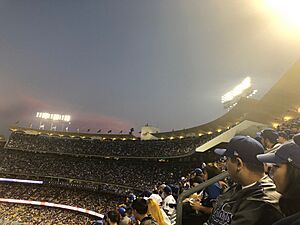
Other Exciting Events at Dodger Stadium
Sports Beyond Baseball
Dodger Stadium has hosted many different sporting events. These include boxing matches, a basketball game with the Harlem Globetrotters, and even a ski-jumping show. It hosted baseball for the 1984 Summer Olympic Games and will again for the 2028 Olympic Games.
In 1992, some baseball games were postponed due to local events in Los Angeles. They were later played as triple-headers.
The stadium hosted a big soccer tournament in 2013. Teams like Los Angeles Galaxy, Real Madrid, Everton, and Juventus played there. In 2014, the Los Angeles Kings and Anaheim Ducks played an outdoor hockey game as part of the NHL Stadium Series.
On November 15, 2015, Dodger Stadium even hosted a cricket match. It was part of the Cricket All-Stars Series 2015. Famous cricket legends Sachin Tendulkar and Shane Warne led their teams.
Concerts and Entertainment

Many famous musicians have performed at Dodger Stadium. These include The Cure, Kiss, The Rolling Stones, The Beatles, Elton John, Lady Gaga, Madonna, Beyoncé, U2, and Paul McCartney. Elton John's concerts in 1975 are especially famous.
In 1994, The Three Tenors (José Carreras, Plácido Domingo, and Luciano Pavarotti) performed a concert. It was watched by a billion people worldwide. In 2022, Gabriel "Fluffy" Iglesias became the first stand-up comedian to perform at the stadium.
Dodger Stadium in Movies, TV, and Games
Dodger Stadium has appeared in many movies and TV shows. It was seen in The Fast and the Furious and Fast X. The stadium was also used as a model for Metropolis's baseball stadium in Superman Returns. You can also see it in Transformers and Creed III.
The stadium even appears in the mobile game Mario Kart Tour as part of the "Los Angeles Laps" race course. This course was later added to Mario Kart 8 Deluxe.
Other Community Events
Pope John Paul II celebrated a special Mass at Dodger Stadium in 1987. The stadium also hosts the "Dodger Holiday Festival" in November and December. This event includes an ice skating rink, light displays, and photos with Santa Claus.
Getting to Dodger Stadium
The stadium is surrounded by large parking lots. Before games, traffic can be heavy on the roads leading to the stadium. The Chinatown station is the closest Los Angeles Metro Rail stop. From there, it's about a mile walk to the stadium.
Dodger Stadium Express Bus
The Dodger Stadium Express is a free bus service for fans with tickets. It takes them to and from the stadium on game days. The service starts 2.5 hours before the game. Buses run from Union Station and from the South Bay.
The Union Station route runs non-stop. It uses special bus lanes to get to the stadium quickly. The South Bay route connects to several Metro stations. This makes it easier for fans to use public transport.
Future Travel Plans
There is a plan for a new aerial gondola called the Los Angeles Aerial Rapid Transit. This gondola would connect Union Station directly to Dodger Stadium. It would also have a stop at the Los Angeles State Historic Park.
Images for kids
See also
 In Spanish: Dodger Stadium para niños
In Spanish: Dodger Stadium para niños








